Reading for students |

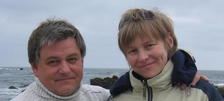
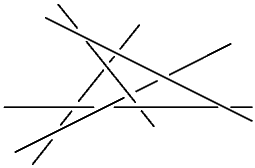 Configurations
of Skew Lines in the 3D Space
Configurations
of Skew Lines in the 3D Space
by Julia Viro and Oleg Viro
This is about links made of lines. One has to require that the lines are
not only disjoint, but also non-parallel. This gives the lines an ability
to be linked with each other. As long as the number of lines is not large (less
than 6), the linking numbers rule. Then the Jones polynomial comes.
On a horizont the Khovanov homology can be recognized...
![]()
 Pictorial Calculus for Isometries,
Pictorial Calculus for Isometries,
American Mathematical
Monthly 123, January 2016
 Introductions into Topology of Real Algebraic Varieties
Introductions into Topology of Real Algebraic Varieties
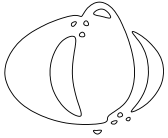
 Introductions to patchworking
Introductions to patchworking
 Gluing of spaces is a landmark of topology.
Cut and paste techniques like surgery, Dehn surgery, connected sum,
decomposition along incompressible surfaces are usual there.
Gluing of spaces is a landmark of topology.
Cut and paste techniques like surgery, Dehn surgery, connected sum,
decomposition along incompressible surfaces are usual there.
In Algebraic Geometry more rigid and rich structure makes
spaces reluctant to allow such a rude treatment.
However, sometimes
an algebraic variety can be described topologically using cut and
paste operations borrowed from topology. Pathworking is a technique
providing varieties made of patches.
 Dequantization of real algebraic geometry on logarithmic
paper
Dequantization of real algebraic geometry on logarithmic
paper
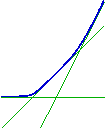 A talk by Oleg Viro at the Third European Congress
of Mathematicians (Barcelona, 2000). It bridged patchworking and
Litvinov - Maslov dequantization of positive real numbers and started up
a broad development of Tropical geometry.
A talk by Oleg Viro at the Third European Congress
of Mathematicians (Barcelona, 2000). It bridged patchworking and
Litvinov - Maslov dequantization of positive real numbers and started up
a broad development of Tropical geometry.
 What is an Amoeba?
Notices
AMS, 49:8
(2002), 916-917, [pdf]
What is an Amoeba?
Notices
AMS, 49:8
(2002), 916-917, [pdf]
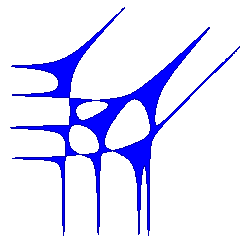 In mathematical terminology the word amoeba is a recent addition introduced
in 1994. A mathematical amoeba falls short in being similar to its
biological prototype. In the simplest case, it is a region the plane,
which may pretend to be a picture of amoeba: a body with several holes
(vacuoles) and straight narrowing tentacles (pseudopods) reaching to
infinity. A planar amoeba is the image of the zero locus of a polynomial
in two variables under the map
$$(\mathbb C\smallsetminus0)^2\to\mathbb R^2: (z,w)\mapsto(\log|z|,\log|w|)$$
In mathematical terminology the word amoeba is a recent addition introduced
in 1994. A mathematical amoeba falls short in being similar to its
biological prototype. In the simplest case, it is a region the plane,
which may pretend to be a picture of amoeba: a body with several holes
(vacuoles) and straight narrowing tentacles (pseudopods) reaching to
infinity. A planar amoeba is the image of the zero locus of a polynomial
in two variables under the map
$$(\mathbb C\smallsetminus0)^2\to\mathbb R^2: (z,w)\mapsto(\log|z|,\log|w|)$$
 On Euler's footsteps,
Evgeny Shchepin's Uppsala lectures on Calculus.
On Euler's footsteps,
Evgeny Shchepin's Uppsala lectures on Calculus.
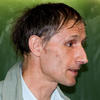
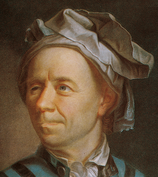 During the Fall Semester of
2001 Prof. Evgeny Shchepin (Moscow Steklov Institute) gave
lectures on Calculus for an advanced group of first year
undergraduate students at Uppsala University.
The course followed the historical development of Analysis: it
started with series, but limits appeared only in the middle,
after integrals. Complex analysis appeared on an early stage motivated
by the needs of real analysis. All turns of the course are internally
motivated.
During the Fall Semester of
2001 Prof. Evgeny Shchepin (Moscow Steklov Institute) gave
lectures on Calculus for an advanced group of first year
undergraduate students at Uppsala University.
The course followed the historical development of Analysis: it
started with series, but limits appeared only in the middle,
after integrals. Complex analysis appeared on an early stage motivated
by the needs of real analysis. All turns of the course are internally
motivated.
Each lecture contains something surprising. For instance, in the first
lecture it is proved that the sum of all the non-negative integer powers of
two (i.e., 1+2+4+8+16+32+...) equals -1, and a practical interpretation of
this equality is presented.
 Elementary Topology.
Textbook in Problems,
Elementary Topology.
Textbook in Problems,
 by O.Ya.Viro, O.A.Ivanov, V.M.Kharlamov and
N.Y.Netsvetaev.
by O.Ya.Viro, O.A.Ivanov, V.M.Kharlamov and
N.Y.Netsvetaev.
